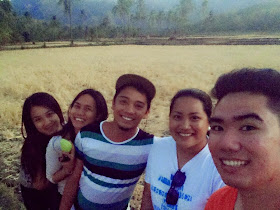Growing up in a sprawling suburb, I have saturated myself
in rich cultures of fiesta and religious celebrations. Come the month of March,
fiestas are celebrated here and there – some,
literally, for barangays are geographically next to one another.
What I like most during fiesta celebrations, aside
from the food because that’s a given, is an opportunity for close relatives and
friends to meet and devour lechon sa
hapag-kainan while throwing each
other jokes or fond memories of the not so distant past, a chance to catch up
with each others’ kadramahan in life
or simple bonding over the game of Majong
with matching round the table tagay because the sumsuman is the irresistible adobo native chicken and crispy
lechonada. The latter was exactly how my most recent pa-miesta. Not to mention that I won P360 in Majong. Hey, that’s already two days
allowance for me.
Since my high school friends are mostly employed , only few of our high school batchmates were able to honor our dear friend Florenz's invitation for fiesta x post-birthday celebration. it was extra special because it was in Igtalongon, a barrio in the town of Igbaras. Despite the scourging heat of the summer sun, we made our way to the barangay. Yes, we were sweating like a pig but the fresh air and so-at-home ambiance that welcomed us with open arms upon reaching the residence was calming.
 |
| We're here! Yes, we are after exactly thirty-nine minutes. |
Lunch is served and so our eyes feasted the very native presentation of the fiesta food to share with the other guests. There's the infamous Pinalabtog and the Binakol too, cooked in kawayan and served with indigenous touch.
 |
| Yuummm yummmm! |
 |
| The obligatory photo before dining |
We had our fill. *Burp* After the delicious buko salad and mouth-watering fresh buko juice, we rested for a while, chilling under the mango tree and pwesto! it was time for water-less swimming- Majong.
 |
| Good vibes. Game started at 2 oçlock PM. |
 |
| Better vibes. Winning Majong, last set of play 5:30 PM. |
Conversation over Majong included the hosts's source of livelihood which was of course farming and livestock. They would visit the town twice or thrice a week to buy some meat to be included and menu and other stuff needed to maintain the livestock and farming, too. The house's location was fairly far from cemented road access but water isn't a problem because of deep well systems. Just because they're in the barrio, they were not isolated from technology for TV and radio were sources of entertainment with good signal too.
Times like this may be too ordinary to the lives of folk people living in rural areas but barrios, or uma in layman's term, is truly home to those who enjoy the comforts of no vehicles rushing, almost-away from unbearable city heat, noise and air pollution-free surroundings with bonus of fresh mango or buko juice whenever you want it. UMArika can really be a place to be because really, the grass is greener here.
 |
| The kind of green you can't say no even by just looking at it. Photo courtesy: Emague |



No comments:
Post a Comment